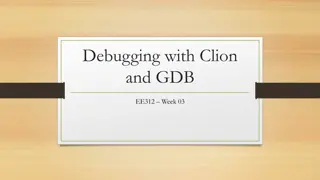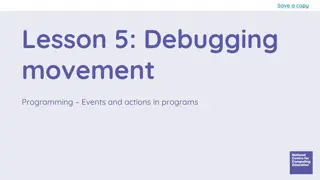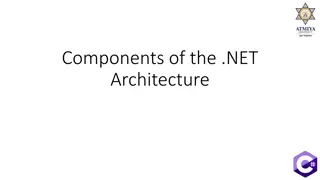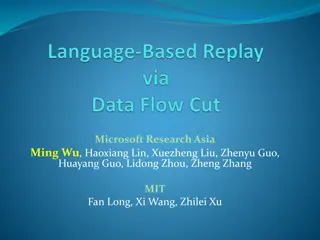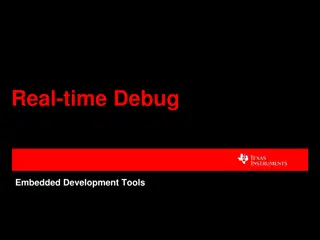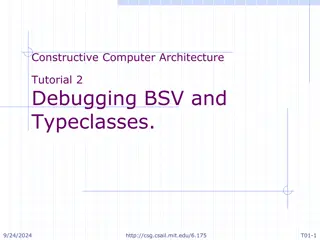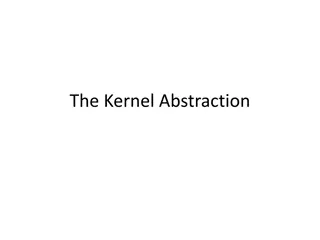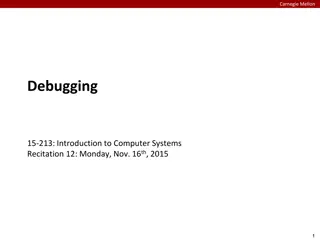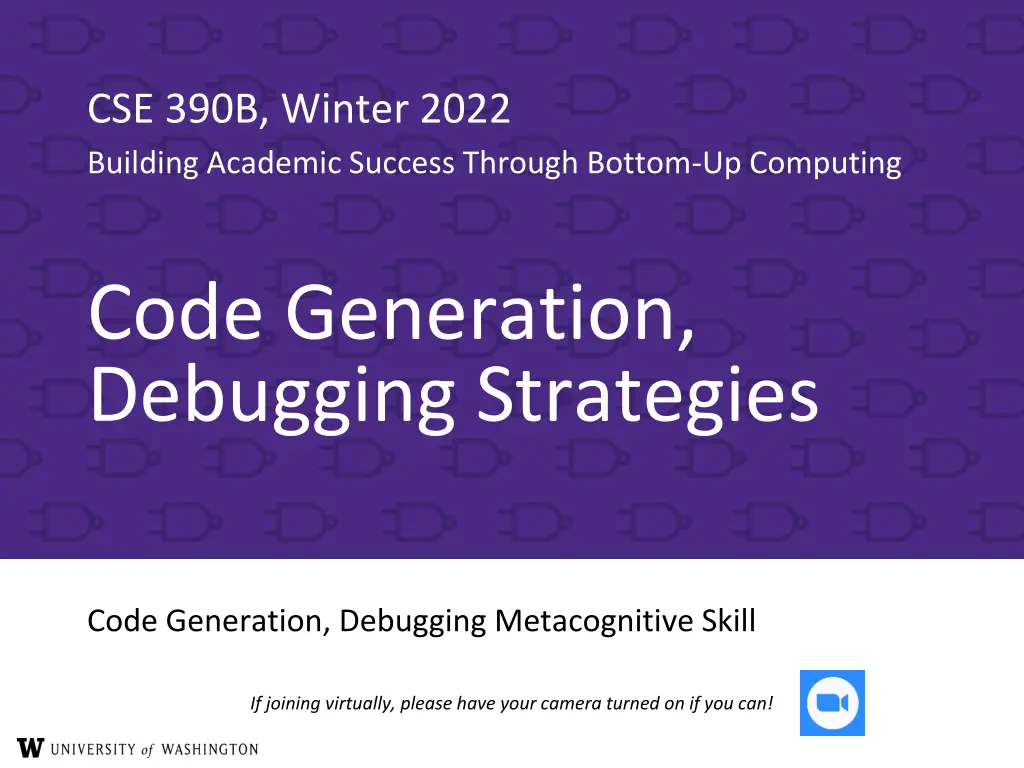
Effective Code Generation and Debugging Strategies in CSE 390B Winter 2022
Explore the key concepts of code generation and debugging in CSE 390B Winter 2022, covering topics such as compilers, high-level languages, assembly languages, and practical implementations. Enhance your metacognitive skills in debugging and learn about the debugging process, strategies, and the scientific method. Dive into the software overview including Java, Python, C/C++, and more, while gaining insights into the compiler's goal and implementation. Discover the process of type checking, code generation, scanning, parsing, optimization, and converting syntax trees to target languages.
Download Presentation

Please find below an Image/Link to download the presentation.
The content on the website is provided AS IS for your information and personal use only. It may not be sold, licensed, or shared on other websites without obtaining consent from the author. If you encounter any issues during the download, it is possible that the publisher has removed the file from their server.
You are allowed to download the files provided on this website for personal or commercial use, subject to the condition that they are used lawfully. All files are the property of their respective owners.
The content on the website is provided AS IS for your information and personal use only. It may not be sold, licensed, or shared on other websites without obtaining consent from the author.
E N D
Presentation Transcript
L15: Code Generation, Debugging CSE 390B, Winter 2022 CSE 390B, Winter 2022 Building Academic Success Through Bottom-Up Computing Code Generation, Debugging Strategies Code Generation, Debugging Metacognitive Skill If joining virtually, please have your camera turned on if you can!
L15: Code Generation, Debugging CSE 390B, Winter 2022 Finals Week Rescheduling Make sure you have filled out the When2meet: https://www.when2meet.com/?14599684-qVIaQ You should have imputed your finals week availability (not preference) to allow us to view as many options as possible 2
L15: Code Generation, Debugging CSE 390B, Winter 2022 Lecture Outline Compilers Overview Scanner, Parser, Type Checker, Optimizer, Code Generator Reading Review and Q&A Code Generation, Takeaways Metacognitive Skill: Debugging Debugging Process and Strategies, The Scientific Method 3
L15: Code Generation, Debugging CSE 390B, Winter 2022 Software Overview Java High-Level Language Python C/C++ Jack Compiler Intermediate Language(s) Java Byte Code Jack VM Code Compiler (Project 7) Compiler (VM Translator) Windows x86, x86-64 Mac Operating System Assembly Language ARM RISC-V HACK Unix/Linux Android Hack OS Assembler SOFTWARE Machine Code
L15: Code Generation, Debugging CSE 390B, Winter 2022 The Compiler: Goal public int fact(int n) { if (n == 0) { return 1; } else { return n * fact(n - 1); } } (fact) @R0 M=M+1 @R1 D=A @ifbranch D;JEQ High-Level Language Theory Definition: a string, from the set of strings making up a language Assembly Language Practical Definition: a file containing a bunch of characters Compiler 5
L15: Code Generation, Debugging CSE 390B, Winter 2022 The Compiler: Implementation public int fact(int n) { if (n == 0) { return 1; } else { return n * fact(n - 1); } } (fact) @R0 M=M+1 @R1 D=A @ifbranch D;JEQ High-Level Language Assembly Language Type Checker Code Generator Scanner Parser Optimizer Break string into discrete tokens: Arrange tokens into syntax tree: Verify the syntax tree is semantically correct Rearrange the code to be more efficient Convert the syntax tree to the target language IF ( ID(n) + == NUM(0) x 10 etc. 6
L15: Code Generation, Debugging CSE 390B, Winter 2022 Lecture Outline Compilers Overview Scanner, Parser, Type Checker, Optimizer, Code Generator Reading Review and Q&A Code Generation, Takeaways Metacognitive Skill: Debugging Debugging Process and Strategies, The Scientific Method 7
L15: Code Generation, Debugging CSE 390B, Winter 2022 Code Generation: The Task @2 D=A @3 D=D+A PLUS left right NUM(2) NUM(3) Hack Assembly Abstract Syntax Tree Convert the AST into target language code that produces the same result Project 7 Goal: Produce reliable, not efficient, compiler The tricky bit: Do it automatically for all possible arrangements of code To stay sane, we ll break the task down: Generate code for each node type in the AST 8
L15: Code Generation, Debugging CSE 390B, Winter 2022 Compile Time vs. Run Time Compile Time Run Time @2 D=A @3 D=D+A PLUS let x = 2 + 3; behavior right left NUM(3) NUM(2) Jack Hack Assembly Output (a Hack program) is running on the Hack computer Compiler (a Java program) is running Generates Hack instructions that will be run later Know value of variables, which code path is taken Know types of variables, but DO NOT KNOW value of variables, which code path is taken 9
L15: Code Generation, Debugging CSE 390B, Winter 2022 Code Generation: Example Here s how you, a brilliant human, would likely translate this syntax tree into Hack: @2 D=A @3 D=D+A Hack Assembly Human (practically a genius) PLUS left right NUM(2) NUM(3) Abstract Syntax Tree 10
L15: Code Generation, Debugging CSE 390B, Winter 2022 Code Generation: Example Here s how you, a brilliant human, would likely translate this syntax tree into Hack: @2 D=A @3 D=D+A Hack Assembly Human (practically a genius) @2 D=A @R0 M=D // save R0 somehow PLUS left right NUM(2) NUM(3) @3 D=A @R0 M=D Computer (trying its best) Abstract Syntax Tree @R0 D=M // restore R0 @R0 MD=D+M 11 Hack Assembly
L15: Code Generation, Debugging CSE 390B, Winter 2022 Code Generation: Example Why? Modularity: We can fit any expression in that slot, as long as its result ends up in R0! @2 D=A @R0 M=D NUM(2) PLUS // save R0 somehow Computer (actually pretty clever!) left right PLUS @3 D=A @R0 M=D NUM(2) NUM(3) NUM(3) Abstract Syntax Tree @R0 D=M // restore R0 @R0 MD=D+M 12
L15: Code Generation, Debugging CSE 390B, Winter 2022 Code Generation: Example Why? Modularity: We can fit any expression in that slot, as long as its result ends up in R0! Even another ! PLUS @2 D=A @R0 M=D NUM(2) PLUS // save R0 somehow left right PLUS @3 D=A @R0 M=D NUM(2) PLUS NUM(3) left right NUM(1) NUM(2) @R0 D=M // restore R0 @R0 MD=D+M Abstract Syntax Tree 13
L15: Code Generation, Debugging CSE 390B, Winter 2022 Code Generation: Example Now, we need to Save R0 somehow What if we save it in a temp register? Let s pick R2 @2 D=A @R0 M=D NUM(2) @R0 D=M @R2 M=D PLUS left right PLUS NUM(2) NUM(3) @3 D=A @R0 M=D NUM(3) Abstract Syntax Tree @R0 D=M // restore (reverse) @R0 MD=D+M 14
L15: Code Generation, Debugging CSE 390B, Winter 2022 Code Generation: Example Now, we need to Save R0 somehow What if we save it in a temp register? Let s pick R2 @2 D=A @R0 M=D NUM(2) @R0 D=M @R2 M=D PLUS left right PLUS NUM(2) NUM(3) @3 D=A @R0 M=D NUM(3) Abstract Syntax Tree @R0 D=M // restore (reverse) @R0 MD=D+M Why won t this always work? 15
L15: Code Generation, Debugging CSE 390B, Winter 2022 Code Generation: Example It s those pesky nested expressions! The outer PLUS saves a value in R2, but the inner PLUS overwrites that value during its computation @2 D=A @R0 M=D NUM(2) PLUS // save R0 in R2 PLUS left right @1 D=A ... // save R0 in R2 ... @R0 MD=D+M NUM(2) PLUS PLUS left right NUM(1) NUM(2) Abstract Syntax Tree @R0 D=M // restore R0 from R2 (!) @R0 MD=D+M 16
L15: Code Generation, Debugging CSE 390B, Winter 2022 PLUS Code Generation: Example left right PLUS NUM(2) left right Solution: Store saved values in a stack Not quite the same as The Stack or function call stack frames (but used for a similar reason) We ll keep a stack starting at memory address 1024 R1 is our stack pointer: always stores address of last used stack position No built-in Hack push: manually copy to memory and increment R1 NUM(1) NUM(2) Abstract Syntax Tree @2 D=A @R0 M=D NUM(2) // push R0 to slot 0 PLUS @1 ... // push R0 to slot 1 ... // pop R0 from slot 1 @R0 MD=D+M PLUS @R0 D=M // pop R0 from slot 0 @R0 MD=D+M R1 1024 1025 1026 1027 1025 (R0) (R0) 17
L15: Code Generation, Debugging CSE 390B, Winter 2022 Code Generation: Example What about variables? arr 256 var int arr[5]; var int bar, star; @261 D=M @262 M=D bar 261 let bar = star; star 262 Hack Assembly Jack screen 16384 Just like Assembler: Generate symbol table with mapping from variable names to spots in memory Arrays get more (contiguous) spots screen and keyboard are built-in array variables, allowing I/O 18
L15: Code Generation, Debugging CSE 390B, Winter 2022 Code Generation: Takeaways Code Generation task: Writing several small snippets of Hack assembly But need to be very generalizable Whenever a PLUS expression is encountered, should generate almost the same code Conventions make the task much easier E.g., after any expression code runs, result should always be stored in R0 Then parent code can depend on it! 19
L15: Code Generation, Debugging CSE 390B, Winter 2022 Lecture Outline Compilers Overview Scanner, Parser, Type Checker, Optimizer, Code Generator Reading Review and Q&A Code Generation, Takeaways Metacognitive Skill: Debugging Debugging Process and Strategies, The Scientific Method 20
L15: Code Generation, Debugging CSE 390B, Winter 2022 Sources and Acknowledgements This is a subset and an adaptation of a CSE 331 lecture If you have taken CSE 331, you have seen this before Part of your task for Project 7 This subject is closely connected to metacognition If you haven t taken CSE 331, this is a helpful sneak peek Debugging is an important topic in many CSE courses Acknowledgements: CSE 331 instructors, notably Michael D. Ernst, Hal Perkins, and more 21
L15: Code Generation, Debugging CSE 390B, Winter 2022 Debugging Pre-discussion How often do you run into bugs when writing programs? What is your debugging process? In other words, when you run into a bug, do you have strategies that you consistently use to find it? For those who have taken 331, maybe think back to before you had the debugging lecture What debugging strategies have you come across? 22
L15: Code Generation, Debugging CSE 390B, Winter 2022 A Bug s Life Software bug definitions: defect mistake committed by a human error incorrect computation failure visible error: program violates its specification Debugging starts when a failure is observed During testing In the field Goal is to go from failure back to defect 23
L15: Code Generation, Debugging CSE 390B, Winter 2022 Testing Versus Debugging Testing debugging Test: reveals existence of problem (failure) Debug: pinpoint location + cause of problem (defect) See CSE 331 for: How to write code that has fewer bugs (so less debugging) How to write code that is easier to test (so easier to reveal bugs) How to make testing easier (so you do it more often) How to write code that is easier to debug (so less time spent debugging) These are all incredibly valuable engineering skills! 24
L15: Code Generation, Debugging CSE 390B, Winter 2022 Last (Inevitable) Resort: Debugging Defects happen, people are imperfect Industry average: 10 defects per 1000 lines of code (?) Defects happen that are not immediately localizable Found during integration testing Or reported by user Cost of an error increases by orders of magnitude during program lifecycle 25
L15: Code Generation, Debugging CSE 390B, Winter 2022 Debugging Lifecycle Step 1: Clarify symptom (simplify input), create minimal test Step 2: Find and understand cause Step 3: Fix and understand why it works Step 4: Rerun all tests, old and new 26
L15: Code Generation, Debugging CSE 390B, Winter 2022 The Debugging Process Step 1: Find small, repeatable test case that produces the failure May take effort, but helps identify the defect and gives you a regression test Do not start Step 2 until you have a simple repeatable test Step 2: Narrow down location and proximate cause Loop: (a) Study the data (b) hypothesize (c) experiment Experiments often involve changing the code Do not start Step 3 until you understand the cause 27
L15: Code Generation, Debugging CSE 390B, Winter 2022 The Debugging Process Step 3: Fix the defect Is it a simple typo, or a design flaw? Does it occur elsewhere? Step 4: Add test case to regression suite Is this failure fixed? Are any other new failures introduced? 28
L15: Code Generation, Debugging CSE 390B, Winter 2022 Debugging and The Scientific Method Debugging should be systematic Carefully decide what to do Don t flail! Keep a record of everything that you do Don t get sucked into fruitless avenues Home Use an iterative scientific process: Formulate a hypothesis Interpret results Design an experiment Perform an experiment 29
L15: Code Generation, Debugging CSE 390B, Winter 2022 Debugging Example // returns true iff sub is a substring of full // (i.e., iff there exists A,B such that full=A+sub+B) boolean contains(String full, String sub); User bug report: Cannot find string "very happy" in: "F ilte, you are very welcome! Hi Se n! I am very very happy to see you all." Poor responses: Notice accented characters, panic about not knowing about Unicode, begin unorganized web searches and inserting poorly understood library calls, Start tracing the execution of this example Better response: simplify/clarify the symptom 30
L15: Code Generation, Debugging CSE 390B, Winter 2022 Reducing Absolute Input Size Find a simple test case by divide-and-conquer Pare test down: Cannot find "very happy" within "F ilte, you are very welcome! Hi Se n! I am very very happy to see you all. "I am very very happy to see you all. "very very happy" Can find "very happy" within "very happy" Cannot find "ab" within "aab" 31
L15: Code Generation, Debugging CSE 390B, Winter 2022 Reducing Relative Input Size Can you find two almost identical test cases where one gives the correct answer and the other does not? Cannot find "very happy" within "I am very very happy to see you all." Can find "very happy" within "I am very happy to see you all. 32
L15: Code Generation, Debugging CSE 390B, Winter 2022 General Strategy: Simplify In general: Find simplest input that will provoke failure Usually not the input that revealed existence of the defect Start with data that revealed the defect Keep paring it down ( binary search can help) Often leads directly to an understanding of the cause When not dealing with simple method calls: The test input is the set of steps that reliably trigger the failure Same basic idea 33
L15: Code Generation, Debugging CSE 390B, Winter 2022 Localizing a Defect Take advantage of modularity Start with everything, take away pieces until failure goes away Start with nothing, add pieces back in until failure appears Take advantage of modular reasoning Trace through program, viewing intermediate results Binary search speeds up the process Error happens somewhere between first and last statement Do binary search on that ordered set of statements 34
L15: Code Generation, Debugging CSE 390B, Winter 2022 Binary Search on Buggy Code public class MotionDetector { private boolean first = true; private Matrix prev = new Matrix(); no problem yet public Point apply(Matrix current) { if (first) { prev = current; } Matrix motion = new Matrix(); getDifference(prev,current,motion); applyThreshold(motion,motion,10); labelImage(motion,motion); Hist hist = getHistogram(motion); int top = hist.getMostFrequent(); applyThreshold(motion,motion,top,top); Point result = getCentroid(motion); prev.copy(current); return result; } Check intermediate result at half-way point } problem exists 35
L15: Code Generation, Debugging CSE 390B, Winter 2022 Binary Search on Buggy Code public class MotionDetector { private boolean first = true; private Matrix prev = new Matrix(); no problem yet public Point apply(Matrix current) { if (first) { prev = current; } Matrix motion = new Matrix(); getDifference(prev,current,motion); applyThreshold(motion,motion,10); labelImage(motion,motion); Hist hist = getHistogram(motion); int top = hist.getMostFrequent(); applyThreshold(motion,motion,top,top); Point result = getCentroid(motion); prev.copy(current); return result; } Check intermediate result at half-way point problem exists } 36
L15: Code Generation, Debugging CSE 390B, Winter 2022 Detecting Bugs in the Real World Real Systems Large and complex Collection of modules, written by multiple people Complex input Many external interactions Nondeterministic Replication can be an issue Infrequent failure Instrumentation eliminates the failure No printf or debugger Errors cross abstraction barriers Large time lag from corruption (error) to detection (failure) 37
L15: Code Generation, Debugging CSE 390B, Winter 2022 Heisenbugs In a sequential, deterministic program, failure is repeatable But the real world is not that nice Continuous input/environment changes Timing dependencies Concurrency and parallelism Failure occurs randomly Depends on results of random-number generation Hash tables behave differently when program is rerun Bugs hard to reproduce when: Use of debugger or assertions makes failure goes away Due to timing or assertions having side-effects Only happens when under heavy load and once in a while 38
L15: Code Generation, Debugging CSE 390B, Winter 2022 Logging Events Log (record) events during execution as program runs (at full speed) Examine logs to help reconstruct the past Particularly on failing runs And/or compare failing and non-failing runs But don t spend too much time manually reading enormous, confusing logs 39
L15: Code Generation, Debugging CSE 390B, Winter 2022 More Tricks for Hard Bugs Rebuild system from scratch, or restart/reboot Find the bug in your build system or persistent data structures Explain the problem to a friend (or to a rubber duck) Make sure it is a bug Program may be working correctly and you don t realize it! Face reality Debug reality (actual evidence), not what you think is true And things we already know: Minimize input required to exercise bug (exhibit failure) Add more checks to the program Add more logging 40
L15: Code Generation, Debugging CSE 390B, Winter 2022 Where is the defect? The defect is not where you think it is Ask yourself where it cannot be; explain why Self-psychology: look forward to being wrong! Look for simple easy-to-overlook mistakes first, e.g., Reversed order of arguments Spelling of identifiers Same object vs. equal: a == b versus a.equals(b) Uninitialized data/variables Deep vs. shallow copy Make sure that you have correct source code! Check out fresh copy from repository; recompile everything Does a syntax error break the build? (it should!) 41
L15: Code Generation, Debugging CSE 390B, Winter 2022 When the going gets tough Reconsider assumptions Debug the code, not the comments Ensure that comments and specs describe the code Start documenting your system Gives a fresh angle, and highlights area of confusion Get help We all develop blind spots Explaining the problem often helps (even to rubber duck) Walk away Trade latency for efficiency sleep! One good reason to start early 42
L15: Code Generation, Debugging CSE 390B, Winter 2022 Key Concepts Testing and debugging are different Testing reveals existence of failures Debugging pinpoints location of defects Debugging should be a systematic process Use the scientific method Understand the source of defects To find similar ones and prevent them in the future Learn from the debugging process It s inevitable and you have some control over how you approach the frustration 43
L15: Code Generation, Debugging CSE 390B, Winter 2022 Debugging Post-discussion In small groups, discuss the following questions: What strategies and concepts resonated most with you from today s lecture? What part of the scientific method process do you feel you are currently strong at? What part do you find is most difficult for you? Why? Formulate a hypothesis Interpret results Design an experiment Perform an experiment 44
L15: Code Generation, Debugging CSE 390B, Winter 2022 Post-Lecture 15 Reminders Project 6 Part I: Midterm Corrections: Due Thursday (2/24) Open-note, open-tool Midterm grade will be the average of your initial midterm grade and your redo score; your midterm grade can only improve No late days or extensions will be granted Project 6 Part II: Professor Meeting Report: due in 1.5 weeks Should have already scheduled your professor meeting Thursday s Reading Review: A Podcast Around twenty-five but should be a nice break from readings See calendar for link/discussion prompts 45


